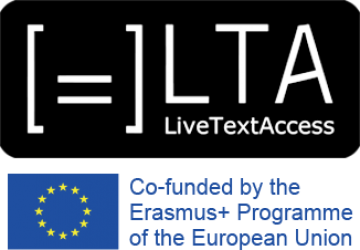A skills card maps competence areas that are associated with a professional profile. Each competence area is organised in Elements, which represent single subject areas. The skills, abilities and knowledge that trainees will acquire during training for each area are described as learning outcomes, in short, LOs.
Our skills card is the result of an online survey conducted during the project. Therefore, it reflects the knowledge of 121 professionals, end-users and stakeholders across Europe, the Asian Pacific and the United States. Each competence area corresponds to a Unit in the LTA course. Click here to download the IO 1 report about the survey.
Unit 1: Understanding Accessibility
This competence area has three Elements.
Element 1. Basic concepts: accessibility, disability, multimodality and Universal Design
LO1: The trainee can explain the differences between the medical and social model of disability.
LO2: The trainee can explain the concepts of disability, accessibility, Universal Design and multimodality, and the differences among them from the perspective of the social model of disability.
LO3: The trainee is able to design accessible working settings for the provision of real-time intralingual subtitles by applying the principles of Universal Design and Design for All.
Element 2. Target users and their needs
LO1: The trainee can explain the needs and cultural preferences of the hard-of-hearing, deaf, and deaf-blind community, and other end users of real-time subtitles.
LO2: The trainee can explain the concepts of hearing, hearing loss and assistive technology and how they relate to the needs of end-users of real time subtitles: hard-of-hearing, deaf, and deaf-blind community.
LO3: The trainee can communicate in sign language in basic job-related situations.
Element 3. How to embed accessibility in real-time intralingual subtitling working environments
LO1: The trainee can explain the role and competences of the real-time translator as communication mediators for each LTA trained working contexts.
LO2: The trainee can classify real-time intralingual working contexts according to transversal accessibility features that facilitate participation for all.
LO3: The trainee can advise customers about how to best set up an accessible real-time working environment for persons with hearing loss in the trained working contexts (education, broadcasting services, cultural events, at work, parliamentary assemblies) and settings (face-to-face and online).
Unit 2: Linguistic competence
This competence area has three Elements.
Element 1. Functionality, accuracy, readability and legibility
LO1: The trainee can produce accurate transcriptions in terms of spelling, grammar and meaning.
LO2: The trainee can identify when non-verbal elements need to be described for each working contexts.
LO3: The trainee can produce legible and readable transcriptions both while creating the transcripts and after the live situation by applying readability and legibility indicators.
Element 2. Strategies to acquire and develop specific thematic knowledge
LO1: The trainee can search terminology, identify reliable sources, manage the terminology, and implement it in real-time working situations.
LO2: The trainee can generate specific glossaries according to the topic of the real-time job and implement them according to the techniques by creating shortcuts.
LO3: The trainee can manage, prepare and implement terminology in real-time intralingual subtitling.
Element 3. How to cope with speech-related challenges
LO1: The trainee can identify speech-related challenges when producing verbatim and sensatim subtitling in compliance with readability standards and when exit strategies (e.g. reformulation) are called for.
LO2: The trainee can simplify the structure of a text by for readability reasons due to complex structures by applying Plain Language strategies.
LO3: The trainee can adjust delay by means of simplification according to the working context, particularly in TV working contexts (due to standards and guidelines).
Unit 3: IT competence
This competence area has three Elements.
Element 1. Input tools
LO1: The trainee can explain the differences, advantages and disadvantages of the different input tools available on the market for both respeaking and typing techniques.
LO2: The trainee can implement strategies to rapidly produce text (macros, house styles, shortcuts) during a real-time job by means of using respeaking software and velotyping/typing software.
LO3: The trainee can use editing software for both verbatim and sensatim.
Element 2. Output tools
LO1: The trainee can explain the differences, advantages and disadvantages of the output tools available on the market (TV subtitling software, other software) for real-time intralingual subtitling.
LO2: The trainee can explain the advantages of output software by the provision of the real-time services and in the different LTA working contexts.
LO3: The trainee can explain the differences, advantages and disadvantages of the different language tools, machine translation and crowdsourcing tools available on the market for real-time subtitles.
Element 3. How to set up the working environment
LO1: The trainee can set up the hardware and software for each type of trained setting and solve problems.
LO2: The trainee can advise clients on technical aspects concerning the provision of subtitles for persons with hearing loss.
LO3: The trainee can test a setting before real-time captioning starts.
Unit 4: Entrepreneurship and management competence
This competence area has three Elements.
Element 1. Management and interpersonal skills
LO1: The trainee knows how to plan job-related tasks by considering other dependencies such as schedule, costs, human and physical resources and related risks.
LO2: The trainee explain strategies to identify possible clients and sponsors in his/her country of real-time intralingual subtitling service.
LO3: The trainee can timely and effectively respond to customer’s requests to ensure accessibility.
Element 2. Stress management and personal skills
LO1: The trainee can explain the main causes of stress derived from the job and different working contexts, and list coping techniques before, during, and after live situations, and develop personal resilience.
LO2: The trainee can deal with feedback as well as provide feedback and solutions in conflictive situations.
LO3: The trainee can remain objective, neutral and follow a code of conduct in the interaction with end-users and costumers at work.
Element 3. Business strategies
LO1: The trainee can prepare himself/herself to conduct professional interviews with customers and potential customers.
LO2: The trainee can develop an own service portfolio and adapt it to the market needs.
LO3: The trainee can evaluate a critical situation, identify the problem, and find solutions.
Unit 5: Respeaking competence
This competence area has five Elements.
Element 1. Psycho-cognitive skills: How to listen and speak simultaneously
LO1: The trainee can reformulate, edit and correct the respoken text during listening (spelling, lexis, grammar, punctuation, proper nouns and numerals).
LO2: The trainee can remember full sentences while lagging behind because of editing/quick speech/other difficulties.
LO3: The trainee can activate exit strategies while respeaking if she/he realises the speaker is challenging (confuse/too intricate grammar, too quick speech-rate, background noise, other).
Element 2. Metalinguistic skills: Turning non-verbal elements into verbal
LO1: The trainee can produce coherent text while respeaking by extracting and combining the information conveyed with the speakers’ material: slides, videos, and other types of material.
LO2: The trainee can implement non-verbal elements for each LTA trained working context by applying different techniques as changing colours or font-size, or by inserting labels.
LO3: The trainee can type/dictate punctuation while keeping the pace of the speaker.
Element 3: Dictation skills: speaking fluently, quickly, and unambiguously
LO1: The trainee demonstrates command of voice projection, pacing, articulation and modulation to support dictation (e.g. when dictating homophones).
LO2: The trainee uses breathing to support dictation and endurance.
LO3: The trainee has a MARS (Most Accurate and Rapid Speech-to-Text rate) of 140 wpm (700 characters) with a 98% accuracy.
Element 4. Editing skills
LO1: The trainee is able to pre-edit the source text before it is displayed by applying strategies such as uploading glossaries on the topic, adding new words to vocabulary, inserting the names of the speakers, and adding shortforms for difficult words.
LO2: The trainee is able to peri-edit the middle text by typing, editing or rephrasing the text in difficult situations or by avoiding a word when spelling is unsure, such as in proper names or acronyms.
LO3: The trainee is able to do post-editing by correcting own typing mistakes and creating a usable text for a later access (transcript, report, pre-recorded subtitles etc.).
Element 5. Factors for high performance
LO1: The trainee can implement strategies or techniques for self-motivation, trying to reach the best quality of work at all time and in all job circumstances.
LO2: The trainee can use strategies to discipline himself/herself, to practice and improve skills daily, to reach higher speed and accuracy during the real-time situation.
LO3: The trainee can implement strategies or techniques for training and enhancing concentration.
Unit 6: Velotyping competence
This competence area has five Elements.
Element 1. Psycho-cognitive skills: How to listen and type simultaneously
LO1: The trainee is able to type, edit and correct the text during the listening (spelling, lexis, grammar, punctuation, proper nouns and numerals).
LO2: The trainee can remember full sentences while lagging behind because of editing/quick speech/other difficulties.
LO3: The trainee can activate exit strategies while velotyping if she/he realises the speaker is challenging (confuse/too intricate grammar, too quick speech-rate, background noise, other).
Element 2. Metalinguistic skills: Turning non-verbal elements into verbal
LO1: The trainee can produce coherent text while velotyping by extracting and combining the information conveyed with the speakers’ material: slides, videos, and other types of material.
LO2: The trainee can implement non-verbal elements for each LTA trained working context by applying different techniques as changing colours or font-size, or by inserting labels.
LO3: The trainee can type/dictate punctuation while keeping the pace of the speaker.
Element 3: Typing skills
LO1: The trainee is able to use all key combinations on Velotype.
LO2: The trainee is able to reproduce any type of written and spoken text by using all key combinations with a speed of 100 wpm (500 cpm).
LO3: The trainee has a MARS (Most Accurate and Rapid Speech-to-Text rate) of 100 wpm (500 characters) with a 99% accuracy by using correct grammar and spelling.
Element 4. Editing skills
LO1: The trainee is able to pre-edit the source text before it is displayed by applying strategies such as uploading glossaries on the topic, adding new words to vocabulary, inserting the names of the speakers, and adding shortforms for difficult words.
LO2: The trainee is able to peri-edit the middle text by coping, editing or rephrasing the text in difficult situations or by avoiding a word when spelling is unsure, such as in proper names or acronyms.
LO3: The trainee is able to do post-editing before target text by correcting own typing mistakes and creating a usable text for a later access (transcript, report, pre-recorded subtitles etc.). .
Element 5. Factors for high performance
LO1: The trainee can implement strategies or techniques for self-motivation, trying to reach the best quality of work at all time and in all job circumstances.
LO2: The trainee can use strategies to discipline himself/herself, to practice and improve skills daily, to reach higher speed and accuracy during the real-time situation.
LO3: The trainee can implement strategies or techniques for training and enhancing concentration.
2,002 total views, 3 views today

